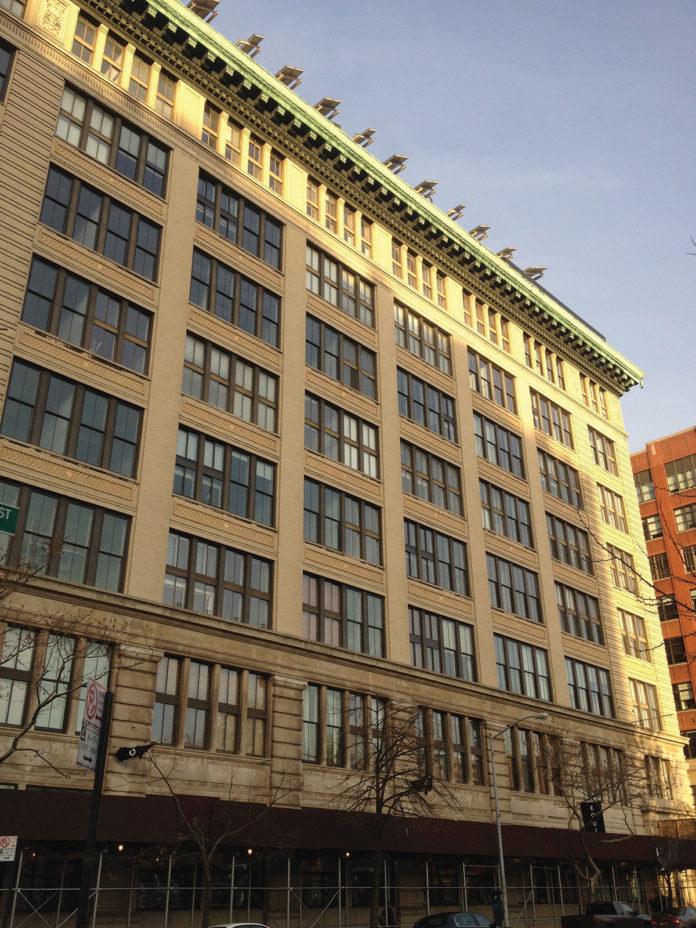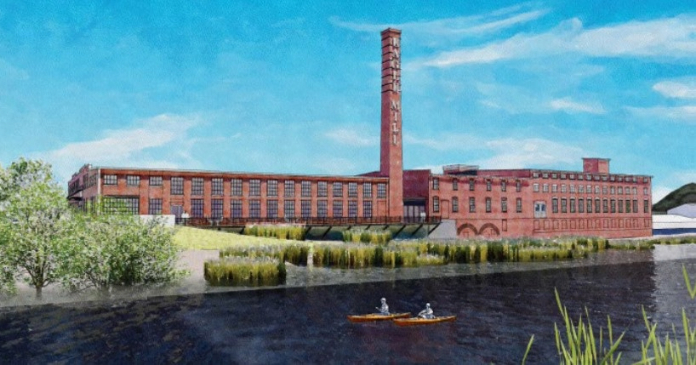
But the dream faded at Printing House—along with dozens of other 1980s condos in New York-as the real estate market entered a long slump. Much of the building, already rentals, have been rented out since.
Many condo projects stalled during the latest real estate crash are being resuscitated and put back up for sale in the past year or so. Now, Printing House, a West Village condo conversion first launched more than a quarter of century ago, is also getting a new life—and a new look.
The remaining 104 apartments are being gutted, combined and put back on the market as 60 larger apartments—with 21st-century prices and designs.
Dark one-bedroom lofts have been reconfigured with glass walls, thin metal railings and open stairs to bring in more light to the upper level.
In the printing era, windows were partitioning by thick horizontal metal bands. Now these have been combined into 9-ft.-high, mullioned windows, many with views across Hudson Street to a city playground. A row of townhouses is planned on a landscaped mews in the back.
Since the 1980s, there has been a flourishing market among investors in blocks of unsold condo units from that era, but only few have had large scale rebirths.
At Morgan Court, a 32-story sliver tower on Madison Avenue built in 1985, sales stalled to the point that the developer allowed it to be used as the backdrop for a dark 1993 thriller movie, “Sliver” starring Sharon Stone, in which a body flies off a balcony.
Sales were relaunched in the 40-unit Morgan Court building in 2007 after renovations. Reba Miller, a broker at CO RE who represents the Morgan Court developer, said that nine of 22 sponsor-owned condos have been sold since. Other apartments are being put on the market as they become vacant, she said.
At Printing House, the lobby was redesigned to evoke the building’s past in the printing industry. The original 1911 vaulted tile ceiling is intact, but there is now a doorman’s desk with a large steel panel on which the Gettysburg Address has been laser-cut in an abstract font, evoking the age of metal type. Steel panels attached to the mailboxes have the Declaration of Independence, according to the architect, Andrew Kotchen of workshop/apd.
He called the redesign “rustic modernism.”
How far the building has come can be seen in changing prices. Back in 1975, the original sponsors, Barnet Liberman and Winthrop Chamberlin, paid $476,000 for the entire building, at a time it was a half vacant printing building, Liberman said.
In 1988, the sponsors sold two 785-sq.-ft., one-bedroom apartments, that together cost close to the price of the building. Now prices on renovated apartments will range between $1.5 million for one-bedrooms and more than $7 million for larger condos, according to Tricia Cole, managing director of Corcoran Sunshine Marketing Group.
Liberman said that he and his partner sold off apartments from time to time over the years, but decided to put the rest of the building on the market a few years ago, at a time when he was nearing retirement age and needed to raise capital some of his other investments, in Florida, Texas and Las Vegas, that did not do as well as Printing House.
They sold most of their interest in the unsold apartments last year for $67.6 million to a group of investors—Myles Horn, Angelo, Gordon & Co. and Belvedere Capital Real Estate Partners. They still retained an ownership share as well.
The closing was delayed for many months because of a lawsuit from a losing bidder in the deal. Now it is coming on the market at a time when there is very little inventory, and the market is stronger than it was a year ago, Horn said.
Kotchen redesigned the hallways, ripping out low ceilings, and replacing them with multilevel spaces soaring to more than 15-feet high in places. Still sales in the buildings have a few challenges: On some floors, head clearance is only about 6-feet from the floor of the loft space to the concrete beams above.
The building also has a few unusual features. It has large solar-heating panels on the roof installed decades ago, before the current wave of green building, but the system is no longer in service.
It also has a large gym on the ground floor that was once a popular center for squash in Manhattan, and a rooftop pool. A few years ago Equinox took over the space, renovated it and replaced the squash courts with exercise equipment. A one-year membership is included with purchase.
Liberman and Chamberlin both live in Printing House in apartments that they have long-owned. In 1986, they turned them into penthouses, by expanding into the roof and adding a level.
Author: Josh Barbanel, Wall Street Journal














